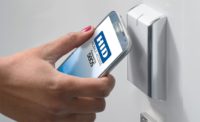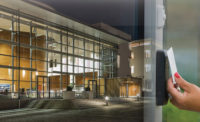
Security System Integration
As Al Albrect, president of systems integrator Security Management Systems of Long Island City, N.Y., puts it, "The big change is integration, integration, integration."By interconnecting access control with intrusion detection or video surveillance systems, integrators can make their customers' systems more powerful - although ironically, what customers often like is the simplicity.
"We see a lot of clients that don't man their guard booth 24/7," Albrect says. "They use integration as a management tool. If it's after hours and a door is left propped open, they want it reported to the central station." That capability is easy to obtain with access control systems that can be easily integrated with alarm systems using RS-232 connections, Albrect adds.
Brian Torney, sales and marketing manager for systems integrator Trans-American Security Services of Burnsville, Minn., echoes those comments. "The driver behind integration is simplicity," he says. Torney has grown accustomed to seeing Post-It notes all around customers' guard stations with remarks such as "When resetting the system, always press this button before pressing that button." By integrating access control with other security systems, the system can become much more intuitive. "If a door is open in a certain hallway, the screen just shows that," he says.
Human Resources Interface
Increasingly, systems integrators also are getting requests to integrate access control systems with customers' human resource systems, such as PeopleSoft and SAP. Integrating those systems helps reduce data entry errors by eliminating the need to input employee information into each system separately. It also helps ensure that when an employee is terminated, that employee's ability to access the premises is deleted simultaneously.Some access control vendors already have developed software to easily integrate with the most popular HR system vendors. As Torney puts it, that capability "is becoming the identifier of an up-to-date supplier." But occasionally, a client wants something out of the ordinary that requires custom software development. That's a situation that Security Management Systems encountered recently with a client that had 5,000 independent contractors, many of whom had access privileges. Whenever contractors' privileges had to be extended, the client had to go through a cumbersome process of re-entering each contractor into the system. Security Management Systems developed custom software for the client that automated this task so that when a contractor's access privileges were due to expire, the manager responsible for that contractor would receive an electronic notification and could renew each contractor with a mouse click.
Emergency Management
Since Sept. 11, 2001, large companies have been increasingly interested in using access control to help manage emergency situations when employees must evacuate a facility. During an emergency, employees typically don't "badge out" in an orderly fashion, so employers often have no idea of which employees might be missing. To address this, some companies are beginning to create what Peter Boriskin, director of technology for Tyco's Software House unit calls "mustering points." The word "muster" comes from the military, meaning to define a situation when personnel are required to assemble at a certain point after completing a mission. Today's corporate mustering points are off-premises locations where a card reader is installed and where employees can badge in to verify that they have left the premises. Some clients are setting up permanent mustering points, while others are making plans to set up temporary mustering points using wireless card readers - a need that Boriskin now can help address by supplying an application programming interface designed for that purpose.Visitor Management
Another customized access control application that large clients are beginning to request is visitor management. This capability, which is already available from several access control vendors, enables authorized personnel to enter information about anticipated visitors into the access control system so that when the visitor arrives, he can quickly receive appropriate authorization. Additionally, an e-mail can be sent automatically to the person whom he is visiting to advise that person of his arrival. Another appealing capability of the system, Albrect explains, is that "the visitor information is linked to the card holder, so you have an audit trail."Network Installation
Systems integrators and their customers also are finding benefits in connecting their access control systems via a data network, sometimes sharing the existing corporate computer network. Trans-American Security Services has been adding networking capability for clients that have multiple locations so that access control systems do not have to function as isolated islands. Clients want systems to be "semi-autonomous," Torney says. "They want to be able to control all of them from headquarters." Although most clients leave day-to-day control to personnel at each individual location, they like to have the ability to delete a terminated employee from the system remotely in the event that appropriate personnel on site cannot be reached.Security Management Systems has been networking multiple locations for many of its larger access control customers. As part of these upgrades, the company has been connecting each location to a central server farm. This network architecture makes for a less costly installation and provides redundancy, Albrect notes.
One vendor that has creatively leveraged the power of networking is Synergistics. That company recently introduced a browser-based access control system. By connecting the system to the Internet, authorized users can use a browser from any computer to control the system, explains Synergistics CEO Greg Goldman. "They can unlock a door from anywhere in the world," Goldman says. "No locally installed software is required." In addition to marketing the Synergistics system as a product, the company also offers it as a service through central stations with which it has partnered.
Central Station Management
The introduction of remotely managed access controllers has also created another opportunity for companies that operate central stations. More and more central stations are beginning to manage access control systems for their customers over a wide area data connection.Until recently, the biggest challenge here has been that access control management software had not been integrated with central station automation software. But that is beginning to change. Holly Sacks, vice president of marketing for access control developer HID Corp., Irvine, Calif., says that the company has partnered with several vendors of central station software to embed access control functions within alarm monitoring software. Noting that 85 percent of alarm customers do not deploy access control, she believes this new capability will open up a significant untapped market.
Some people question how well customers will accept the idea of turning control of their access systems over to a third party, however. Goldman believes companies will want to control some functions, such as deleting terminated employees from the system, on their own. But smaller companies or companies with many small locations may be more inclined to choose a hosted service, he says.
Biometrics
Once restricted only to the highest end systems, today's biometric readers are becoming part of the mainstream. "Biometrics are much more commonplace now," notes Clifford Franklin, CEO of New York City-based systems integrator Sabre Integrated Security Systems. "Before people thought it was an invasion of privacy, but now people are becoming more and more comfortable with it."Fingerprint-based systems have emerged as the most popular type of biometric readers, thanks to their ease of use and lower cost, while iris scan systems have a niche for high-end applications. Franklin questions the reliability of facial recognition readers, while Albrect questions whether hand geometry systems will ever take off because the readers are more cumbersome. Albrect doesn't see biometric readers replacing card-based systems, however. "Biometrics will never be as heavily used because the throughput is slower," he says.
Smarter Systems
Other new high-end access control applications use sensors to determine the speed, size, and directionality of people and vehicles moving in protected areas. Using that capability, a system can be configured to do certain things - such as to send a video image to security if it identifies a vehicle larger than a car approaching.Systems that use sensors in this manner are becoming increasingly intelligent, notes Boriskin, who has seen school systems interested in being able to detect when someone crosses a playground's boundary. That could possibly indicate that a child had left school property or, depending on directionality, that a potential intruder had stepped onto the property - and a really sophisticated system could detect the difference.
Government Initiatives
The past year has seen a lot of developmental efforts in supporting the federal government's contactless smart card initiative. The goal of that initiative is to have a common access card across all U.S. agencies. The Department of Defense will be the first agency to comply, and others will follow. But virtually all agencies are beginning to develop compliance plans, and some business users may watch what the government does closely with the aim of implementing similar initiatives. HID claims to be the first vendor to have a compliant smart card offering.Physical and Logical Access Convergence
Access control, in the context of this industry, falls into the realm of physical access - or securing entry into a physical location. Logical access - securing entry to an organization's data network - traditionally has been the realm of the information technology department, which has relied primarily on password protection. But interest is growing in using physical access control card readers for logical access.Ideally, businesses and other organizations would like employees to use a single card for both physical and logical access. The hitch is that contact readers which require the physical insertion of a card traditionally have been considered more suitable for logical access, while contactless readers which do not require physical insertion are often the preferred choice for physical access. To address this need, HID - for one - has begun to partner with chip manufacturers to create cards that can support both contact and contactless technology on a single card, Sacks says.
Convenience
As access control systems become more and more powerful, developers are striving to keep the process of designing and installing these systems as simple as possible.One of the labor-saving tools that Sabre Integrated Security Systems has found most useful is estimating software from GE Infrastructure, Security. "You build up your system diagram and it comes up with a price and system drawing all in one," explains Franklin, who says his company has been using the software for about a year with excellent results.
Sabre isn't the only systems integrator looking for time-saving capabilities. "Customers are demanding and looking for systems that are simple in terms of installation and maintenance," notes Rick Sedivy, director of marketing for vendor DKS Door King, Inglewood, Calif. In response, DKS Door King has moved towards more modular systems, Sedivy says. For example, customers can now expand existing access control systems by adding a module via an RS485 connector, eliminating the need to swap out the entire controller, he says.
Fire code compliance
Several high-profile fires involving fatalities in high-rise buildings in recent years are driving stronger enforcement of fire regulations, including those involving door locks. "Today's city and national codes permit the use of electrified locksets only for locking of stairwell doors," notes Rick Geringer, vice president of marketing for SDC Security Door Controls, Westlake Village, Calif. "While a few inspectors may permit access controlled electric strikes and magnetic locks, this is an error, as they do not meet code requirements and may be a threat to high-rise building life safety and a liability for all involved." As a code-compliant alternative for access control systems, SDC has introduced an electrified mortise lockset that complies with building codes where electric strikes and magnetic locks are prohibited.Small companies
Last but not least, another important trend in access control is that companies that never would have used access systems in the past have begun to purchase them. As Chad Luker, product manager for entry systems for system vendor Linear explains it, "Since [Sept. 11], more and more people are conscious of security and access control needs." Over the last few years, Luker has seen a big increase in smaller family-run businesses using access control.The desire for convenience is also driving this trend, notes Torney, who says some small companies purchase access control systems to avoid having to periodically make new keys.
Applications Awaiting Solutions
Despite the creativity that seems to abound in the access control industry today, systems integrators occasionally run across a request from customers that they cannot meet.For example, Trans-American Security Services of Burnsville, Minn., has seen an interest in using access control for condominiums and senior citizens' housing to control entry not only to public spaces, but also to individual units. "They're looking for something halfway between a hotel and an office building system," notes Trans-American sales and marketing manager Brian Torney. Such a system would add an extra level of convenience for residents by eliminating the need for them to carry keys. But Torney says, "there is no product yet that fits that niche."
Meanwhile, New York City-based Sabre Integrated Security Systems has had to turn down requests for access control cards that would have a magnetic stripe to use with vending machines. Sabre CEO Clifford Franklin says he's "not comfortable yet" with options available in that area.
Perhaps Torney's and Franklin's comments will provide food for thought for access control developers as they plan the next generation of product offerings.
Highest Security
Heightened security nationwide is driving some customers, particularly those in the food industry, to attempt to identify and close every potential loophole that they can find in their systems. "We're seeing clients that operate loading docks wanting to know who's driving a truck," notes Brian Torney, sales and marketing manager for Trans-American Security Services, Burnsville, Minn. To address this need, Torney says some vendors are developing devices that can be installed in trucks to hold ID cards. "As the truck drives up, it transmits the information on the ID card," he explains.Alternatively, some customers are looking for a hand-held card reader that a guard would hold, Torney says. When a truck drives up, the guard uses the reader to scan the driver's ID card and check it against information on file to make sure that it belongs to the same person.


